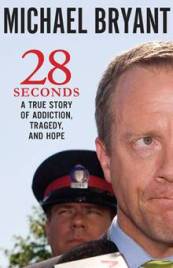 Now that this month’s EAC Toronto branch meeting is almost upon us, we wanted to get you acquainted with Marnie Lamb, who will be giving a presentation all about indexing on March 25. What are the mechanics of creating an index? What type of reader uses an index? Marnie will discuss these questions in the context of her experience indexing Michael Bryant’s 28 Seconds, the memoir of a well-known and controversial Canadian politician.
Now that this month’s EAC Toronto branch meeting is almost upon us, we wanted to get you acquainted with Marnie Lamb, who will be giving a presentation all about indexing on March 25. What are the mechanics of creating an index? What type of reader uses an index? Marnie will discuss these questions in the context of her experience indexing Michael Bryant’s 28 Seconds, the memoir of a well-known and controversial Canadian politician.
Meeting details
March 25, 2014
Miles Nadal Jewish Community Centre, Room 318 (southwest corner of Spadina Avenue and Bloor Street West)
7 PM: Open discussion session for new and prospective EAC members
7:30 PM: Information session and program (Marnie Lamb’s presentation)
9 PM: Mix-and-mingle over coffee, tea, and cake
Meetings are FREE for EAC members and students, and $10 for all other attendees.
Q&A conducted by Laura Godfrey
You mention on your website that you’ve been told you have “the soul of an indexer.” What is it that you enjoy about indexing?
I love to read and to organize information. Like editing, indexing presents me with a great opportunity to be introduced to all kinds of people, places, and ideas I would not otherwise encounter. Through reading manuscripts on indexing jobs, I’ve learned about how deafness was portrayed in Victorian literature, how to make high schools safe for sexual-minority students, and how Canada’s wartime prime ministers each governed. I’ve grown both intellectually and emotionally by better understanding others’ perspectives. I am also constantly creating lists: lists of my clothing, of the movies I’ve watched, of the books I’ve read. The lists are not simple, either. My clothing list, for example, is broken down by season and type of garment and arranged in rainbow order (green tops are listed before blue). Indexing is the perfect marriage of my bibliophilia and my anal-retentiveness!
Where did you first learn the skills necessary to be a good indexer?
When I was asked to index the Sears catalogue, I took a day-long EAC seminar on indexing, taught by Heather Ebbs. That gave me a good introduction to the basics and proved useful for working on the catalogue. However, the catalogue indexing was fairly basic: Dress. Pillow. Stove. When I started freelancing, I knew that to land more challenging work, I needed to upgrade my skills and make connections in the industry. I took the indexing course from Ryerson University’s publishing program. Taught by the fabulous Mary Newberry, the course pushed my indexing skills to a new level, one at which I felt comfortable marketing my services to publishers and scholars seeking indexers.
 Do you find there’s a difference in the work of indexing a trade book (such as Michael Bryant’s memoir, 28 Seconds) versus a scholarly book (or the Sears catalogues you’ve also worked on)?
Do you find there’s a difference in the work of indexing a trade book (such as Michael Bryant’s memoir, 28 Seconds) versus a scholarly book (or the Sears catalogues you’ve also worked on)?
Yes. Scholarly books are more complex because they generally deal with more intricate, challenging, and abstract concepts. These concepts are often difficult to capture in the few words of an index entry. To accommodate the text’s intricate structure, scholarly indexes often have more levels of subheadings than do trade books. Scholarly texts can also be filled with dense jargon. Reading through it can be a bit of a slog! Sometimes, the author needs to be consulted about whether two words are actually synonyms or whether they have slightly different meanings. Trade books are a breezier read and are more straightforward, though they always have entries that are tricky to phrase as well. One benefit of scholarly work is that publishers and academics recognize its challenges and are willing to pay more for a scholarly index.
What is one of the biggest misconceptions about indexing work?
The idea that indexers are wasting their time because readers don’t use indexes. This is not true! The index is the first place to which I turn if I’m looking for information in a non-fiction book. If I don’t find what I’m looking for easily, I become irritated and stop using the index—or worse, stop using the book. It’s not only indexers who use indexes. I’ve had several conversations with friends and editing colleagues surrounding their frustrations with poorly prepared indexes. Like any other information tool—the table of contents, the glossary, the appendix—the index will not be used by all readers. But to state that “no one even looks at the index,” as I’ve heard some say, assumes that all readers think the same way as the speaker. This is astonishingly arrogant.
What advice do you have for an editor trying to decide whether to pursue indexing work? What characteristics or skills does it take?
If you’re unsure whether indexing is for you, the best way to proceed is to take an indexing course. Aside from Ryerson, several universities offer indexing classes, including Simon Fraser University and the University of California at Berkeley. These courses, which range from five weeks to six months, give students the chance to index actual texts. By gaining real-life indexing practice, you’ll know whether indexing is for you.
Indexers and editors have many overlapping skills. Indexers must read very closely and be meticulous and detail oriented to understand and encapsulate the text’s finer points. Yet indexers must also have a sense of the text’s bigger picture to ensure that the index entries “talk” to one another and add up to more than the sum of their parts. So indexers have to be part copy editor and part substantive editor. In my case, being a fiction writer helps me see the larger narrative of each index. That’s another important point: indexing is writing, not editing. Indexers are creating a complementary text, not checking and correcting someone else’s text (although they do have to edit their own indexes before submitting them to clients). People who prefer to work on texts that are already written may not find indexing to their liking.
Laura Godfrey is a Toronto-based copy editor, book reviewer, and editor-in-chief of EAC Toronto branch’s BoldFace blog.
This article was copy edited by Jennifer D. Foster.
